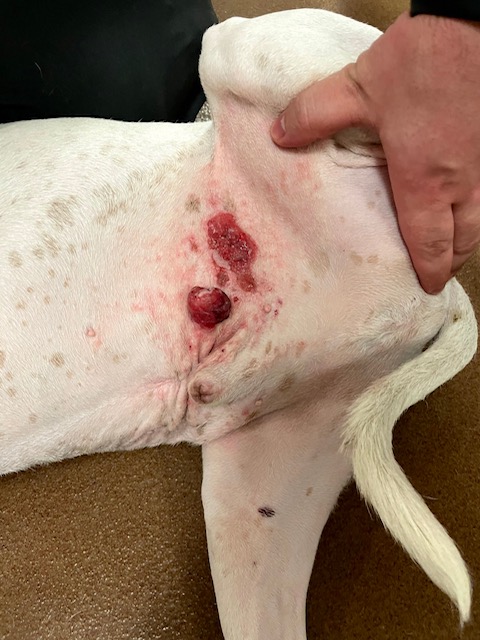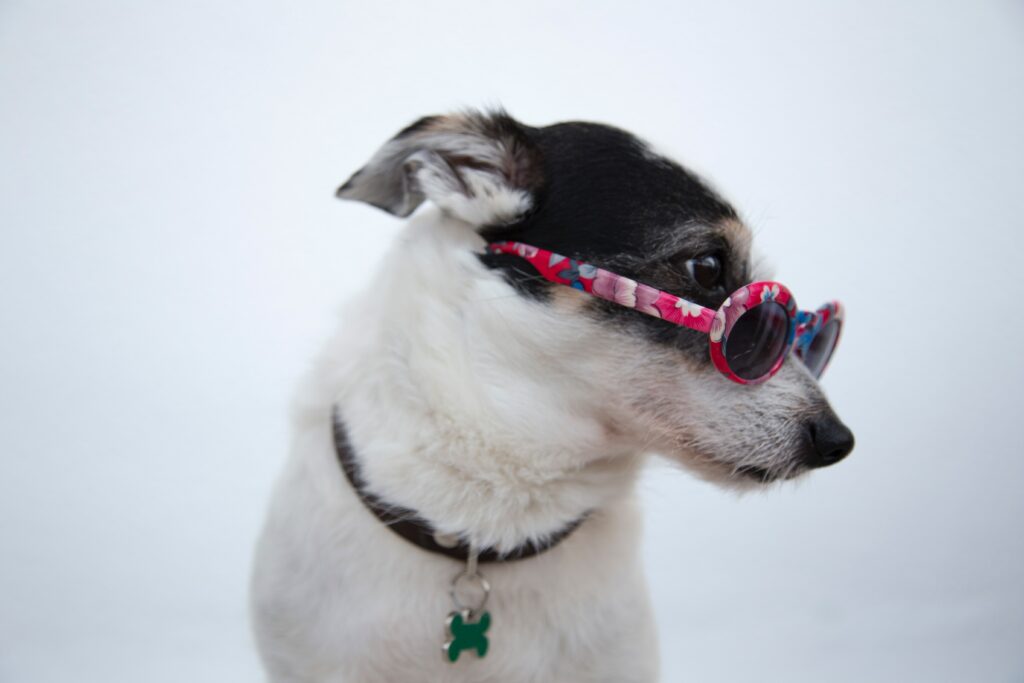Animals can get skin cancer like people. Too much sun exposure is bad for our pets too. Skin cancer in pets is more common than you think.

What is Skin Cancer?
This article is going to focus on skin cancers which are tumors that develop secondary to sun exposure. Our pets can also get skin cancer from too much sun. It is important to provide shade and shelter for our pets when they are outside. Their fur can provide some protection, but breeds with light, thin fur are at greater risks. Also, the areas on the body which do not have fur like the nose and eyelids, are at higher risk.
There are many different types of skin cancer in animals. The most common for our pets is squamous cell carcinoma, melanoma, and cutaneous hemangiosarcoma. These all occur on the body secondary to the sun. Treatment and prognosis can be different between these tumor types. This article is focused on the more common, squamous cell carcinoma.
Squamous Cell Carcinoma
Squamous cell carcinoma involving the skin is relatively common in cats and less often dogs. Squamous cell carcinomas (SCC) are usually found in unpigmented or lightly pigmented skin. Sites commonly affected include the sparsely haired areas of the tip of the nose (nasal planum), ear tips and eyelids. In many patients there is a recognized solar (sun) exposure relationship and are often referred to as “actinic” SCC.
What will You See at Home with Your Pet?
Squamous cell carcinoma may present as either a distinct mass lesion or an erosive lesion which can mimic infection or trauma. These lesions appear similar to scabs or sores on the skin. Erosive lesions that do not respond to antibiotics should increase the suspicion of SCC.

What will Happen at the Vet Clinic with Your Pet?
It can be challenging to determine if there is just a sore or if the ulcer is actually cancer. Definitive diagnosis requires a biopsy. This is usually a small surgery to remove part of the tumor or sore. The tissue will be sent to the lab. Once at the lab, the pathologist will evaluate it, and tell your veterinarian what the tissue is. Once SCC has been diagnosed it is important to check for extent of disease in the body. SCC does not often spread (metastasis) but if it has, the treatment and prognosis will be different. You will need to check the regional lymph nodes with fine needle aspirate and cytology. Chest X-rays are recommended to make sure there is no disease in the lungs. Routine blood work is also recommended to evaluate the overall health of your pet.

What are the Treatment Options for Your Pet?
Decreasing sun exposure is key. This can be done by limiting the time in the sun and clothing to cover the skin. There are designer dog outfits, but you can use kid clothing for some pets. Sun screens and lotions are not always safe in pets and many lick them off right away. Once sun damage has occurred by tumor formation, pets will continue to be at risk of developing more lesions even when sun exposure is decreased.
Cryotherapy
Very small (less than 1 cm), superficial lesions may be treated with cryotherapy. Cryotherapy is the use of cold temperatures to kill cells. Liquid nitrogen is used to perform cryotherapy. The cold temperature creates an “ice ball” which is then capable of destroying cancer cells in the immediate vicinity of the cryotherapy probe. Many pets will have complete and permanent control of the SCC with cryotherapy; however some pets will need to have multiple treatments over time.
Surgery
Large, invasive lesions are best treated with surgical removal. Depending on the extent of the tumor, removal of the pinna of the ears or nasal planum may be required. If surgery achieves complete margins, long term control of the tumor is possible.
Radiation Therapy
Radiation therapy may be recommended for superficial lesions or after surgery if the tumor was not completely removed. For small tumors, radiation therapy will often control the tumor for several years.

What is the Prognosis for Your Pet?
If the SCC is diagnosed early, while still small and superficial, the outcome is good with any of the above mentioned therapies. Once the tumor has become large and invasive, it will not respond to cryotherapy or radiation therapy. Chemotherapy has not been shown to be effective with SCC. Sometimes chemotherapy will be pursued as a palliative option. For large, invasive tumors, aggressive surgery is necessary to control the tumor. This may no longer be an option depending on the tumor size and location.
Many pets will develop other sites of SCC over time. There is no known effective preventative therapy for solar induced SCC other than staying out of the sun. By the time the tumor forms, the sun damage has been done and further lesions will continue to develop.
It can be challenging to know what to do when your pet has been diagnosed with cancer. Thankfully, these tumors generally carry a good prognosis unless the lesions are severe and huge. Be proactive and see your veterinarian if you see a sore that is not healing normally and/or if you see a tumor. A veterinary oncologist is another good resource to help guide you through the best options for your pet and your family. Pet Cancer Care Consulting is a service which partners boarded oncologists with your family veterinarian to increase access to oncologist. This way you can get more information and help you determine the next best steps for you pet. Look into Pet Cancer Care Consulting to see how we can help you.

